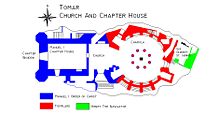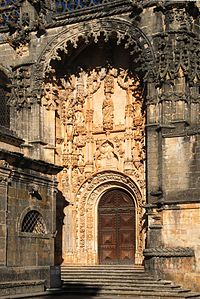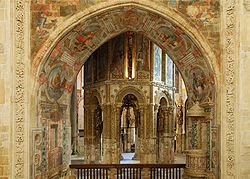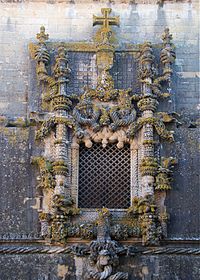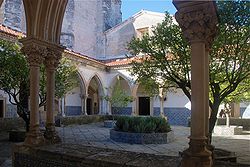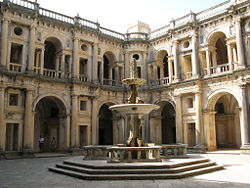- Convent of Christ (Tomar)
-
Convent of Christ in Tomar * UNESCO World Heritage Site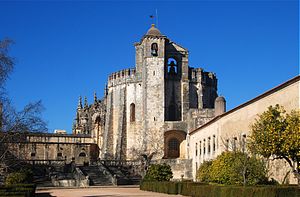
Round Church of the Convent of ChristCountry Portugal Type Cultural Criteria i, vi Reference 265 Region ** Europe and North America Inscription history Inscription 1983 (7th Session) * Name as inscribed on World Heritage List
** Region as classified by UNESCOThe Convent of the Order of Christ (Portuguese: Convento de Cristo) is a religious building and Roman Catholic building in Tomar, Portugal, originally a Templar stronghold built in the 12th century. After the Order of the Knights Templar was dissolved in the 14th century, the Portuguese branch of the order was turned into the Knights of the Order of Christ, which supported Portugal's maritime discoveries of the 15th century.
The Convent of Christ of Tomar is one of Portugal's most important historical and artistic monuments and has been in the World Heritage list of UNESCO since 1983.
Contents
History
Templar stronghold
The castle of the Knights Templar of Tomar was built by Gualdim Pais, provincial Master of the Order of the Temple, around 1160. Later in that century, the castle was chosen as the headquarters of the order in Portugal. The castle of Tomar was part of the defence system created by the Templars to secure the border of the young Christian Kingdom against the Moors, which at the time (mid-12th century) corresponded approximately to the Tagus river.
 Panorama: Castle of Tomar with the Convent of Christ inside. The citadel with the keep is seen in the centre of the image and the round church (with a bell-tower) is to the right.
Panorama: Castle of Tomar with the Convent of Christ inside. The citadel with the keep is seen in the centre of the image and the round church (with a bell-tower) is to the right.
The famous round church (rotunda) of the castle of Tomar was also built in the second half of the 12th century. The church, like some other templar churches throughout Europe, was modelled after the Dome of the Rock in Jerusalem, which was believed by the crusaders to be a remnant of the Temple of Solomon. The Church of the Holy Sepulchre of Jerusalem may also have served as model.
According to Christian chroniclers, the castle of Tomar resisted in 1190 the attacks of caliph Abu Yusuf al-Mansur, who had previously taken other Portuguese strongholds to the South. A plaque near the entrance of the castle church remembers the feat.
Seat of the Order of Christ
The Templar order was suppressed throughout most of Europe from 1312–1314, but in Portugal its members, assets, and partly its membership were transmitted to the Order of Christ, created in 1319 by King Dinis. The Order of Christ moved to Tomar in 1357, which became its headquarters.
One of the most important Grand Masters of the Order was Prince Henry the Navigator, who ruled the Order from 1417 up to his death in 1460. Prince Henry gave great impulse to the pioneering Portuguese expeditions during the Age of Exploration. In the Convent, Prince Henry ordered the construction of various cloisters and other buildings. He also sponsored urban improvements in the town of Tomar itself.
Another important personality related to the Order was King Manuel I, who became Master of the Order in 1484 and King of Portugal in 1492. Under his reign there were several important improvements in the Convent, specially the addition of a new nave to the round church and its inner decoration with paintings and sculptures.
The successor of Manuel I, King John III, demilitarised the order, turning it into a more religious order with a rule based on that of Bernard of Clairvaux. He also ordered the construction of a new cloister in 1557, which is one of the best examples of Renaissance architecture in Portugal.
In 1581, after a succession crisis, the Portuguese Nobility gathered in the Convent of Christ in Tomar and officially recognised Philip II of Spain (Philip I of Portugal) as King. This is the beginning of the Iberian Union (1581–1640), during which the Kingdoms of Portugal and Spain were united. The aqueduct of the Convent was built during the Spanish reign.
Art and architecture
The castle and Convent of Christ have examples of Romanesque, Gothic, Manueline and Renaissance architectural styles.
Castle and walls
The castle of Tomar was built around 1160 on a strategic location, over a hill and near river Nabão. It has an outer defensive wall and a citadel (alcáçova) with a keep inside. The Keep, a central tower of residential and defensive functions, was introduced in Portugal by the Templars, and the one in Tomar is one of the oldest in the country. Another novelty introduced in Portugal by the Templars( learned from decades of experience in Normandy and Brittany and elsewhere) are the round towers in the outer walls, which are more resistant to attacks than square towers. When the town was founded, most of its residents lived in dwellings located inside the protective outer walls of the castle.
Round church
The Romanesque round church is a Roman Catholic Church from the castle (charola, rotunda) was built in the second half of the 12th century by the Knights Templar. From the outside, the church is a 16-side polygonal structure, with strong buttresses, round windows and a bell-tower. Inside, the round church has a central, octagonal structure, connected by arches to a surrounding gallery (ambulatory). The general shape of the church is modelled after similar round structures in Jerusalem: the Mosque of Omar and the Church of the Holy Sepulchre.
The capitals of the columns are still Romanesque (end of 12th century) and depict vegetal and animal motifs, as well as a Daniel in the Lions' Den scene. The style of the capitals shows the influence of artists working on the Cathedral of Coimbra, which was being built at the same time as the round church.
The interior of the round church is magnificently decorated with late gothic/manueline sculpture and paintings, added during a renovation sponsored by King Manuel I starting in 1499. The pillars of the central octagon and the walls of the ambulatory have polychrome statues of saints and angels under exuberant Gothic canopies, while the walls and ceilings of the ambulatory are painted with Gothic patterns and panels depicting the life of Christ. The paintings are attributed to the workshop of the court painter of Manuel I, the Portuguese Jorge Afonso, while the sculptured decoration is attributed to Flemish sculptor Olivier de Gand and the Spaniard Hernán Muñoz. A magnificent panel depicting the martyrdom of Saint Sebastian, by Portuguese painter Gregório Lopes, was painted for the Round Church and now hangs in the National Museum of Ancient Art in Lisbon.
During the administration of Prince Henry the Navigator (first half of the 15th century), a gothic nave was added to the round church of the Convent, thus turning the round church into a church apse. From 1510 onwards, King Manuel I ordered the rebuilding of the nave in the style of the time, a mix of late gothic and renaissance that would be called Manueline style by art historians. The architects involved were the Portuguese Diogo de Arruda and the Spaniard João de Castilho.
From the outside, the rectangular nave is covered by abundant Manueline motifs, including gargoyles, gothic pinnacles, statues and "ropes" that remind the ones used in the ships during the Age of Discovery, as well as the Cross of the Order of Christ and the emblem of King Manuel I, the armillary sphere. The so-called Window of the Chapter House (Janela do Capítulo), a huge window visible from the Saint Barbara Cloister in the Western façade of the nave, carries most of the typical Manueline motifs: the symbols of the Order of Christ and of Manuel I, and fantastic and unprecedented elaborations of ropes, corals and vegetal motifs. A human figure in the bottom of the window probably represents the designer, Diogo de Arruda. This window of the Convent constitutes one of the masterworks of Manueline decoration. Above is a smaller circular window and a balustrade. The façade is divided by two string courses of knotted ropes. The round angle buttresses are decorated with gigantic garters (alluding to investiture of Manuel I by the Order of the Garter by the English king Henry VII).
The entrance of the church is done through a magnificent lateral portal, also decorated with abundant Manueline motifs and statues of the Virgin with the Child as well as the Prophets of the Old Testament. This portal was designed by João de Castilho around 1530.
In the interior, the Manueline nave is connected to the Romanesque round church by a large arch. The nave is covered by beautiful ribbed vaulting and has a high choir that used to have Manueline choir stalls, unfortunately destroyed by invading Napoleonic troops in the early 19th century. Under the high choir there is a room that used to be the sacristy of the church. Its window is the famous Chapter House Window already mentioned.
Cloisters
The Convent of Christ has a total of eight cloisters, built in the 15th and 16th centuries. Some examples:
- Claustro da Lavagem (Washing Cloister): Two-storey gothic cloister built around 1433 under Henry the Navigator. The garments of the monks used to be washed in this cloister, hence the name.
- Claustro do Cemitério (Cloister of the Cemetery): Also built under Henry the Navigator, this gothic cloister was the burial site for the knights and monks of the Order. The elegant twin columns of the arches have beautiful capitals with vegetal motifs, and the walls of the ambulatory are decorated with 16th-century tiles. In a manueline tomb (circa 1523) rests Diogo da Gama, brother of navigator Vasco da Gama.
- Claustro de Santa Bárbara (Saint Barbara's Cloister): Built in the 16th century. The Chapter House Window and the West façade of the manueline nave of the church are visible from this cloister.
- Claustro de D. João III (Cloister of John III): Started under King John III of Portugal, was finished during the reign of Philip I of Portugal (also King of Spain under the name of Philip II). The first architect was the Spaniard Diogo de Torralva, who began the work in 1557, to be finished in 1591 by Philip II's architect, the Italian Filippo Terzi. This magnificent, two-storey cloister connects the dormitory of the monks to the church, and is considered one of the most important examples of Mannerist architecture in Portugal. The storeys are connected to each other by four elegant helicoidal stairways, located at each corner of the cloisters.
See also
- Knights Templar
- Order of Christ (Portugal)
- Tomar
- Church of Santa Maria do Olival
- Krak des Chevaliers
References
- Portugal/1 - Europa Romanica, Gerhard N Graf, Ediciones Encuentro, Madrid, 1987
- Portuguese Institute for Architectural Heritage [1]
- General Bureau for National Buildings and Monuments (Portugal) [2]
World Heritage Sites in Portugal Norte Alto Douro Wine Region · Historic Centre of Guimarães · Historic Centre of Porto · Prehistoric Rock-Art Sites in the Côa Valley and Siega Verde1
Centro Lisboa Cultural Landscape of Sintra · Monastery of the Hieronymites and Belém Tower, Lisbon
Alentejo Historic Centre of Évora
Azores Madeira 1 Shared with other region/s and Spain Categories:- 1160s architecture
- Christian monasteries in Portugal
- Romanesque architecture in Portugal
- Gothic architecture in Portugal
- Manueline architecture
- Renaissance architecture in Portugal
- Knights Templar
- Christianity in Portugal
- Convents in Portugal
- World Heritage Sites in Portugal
Wikimedia Foundation. 2010.

